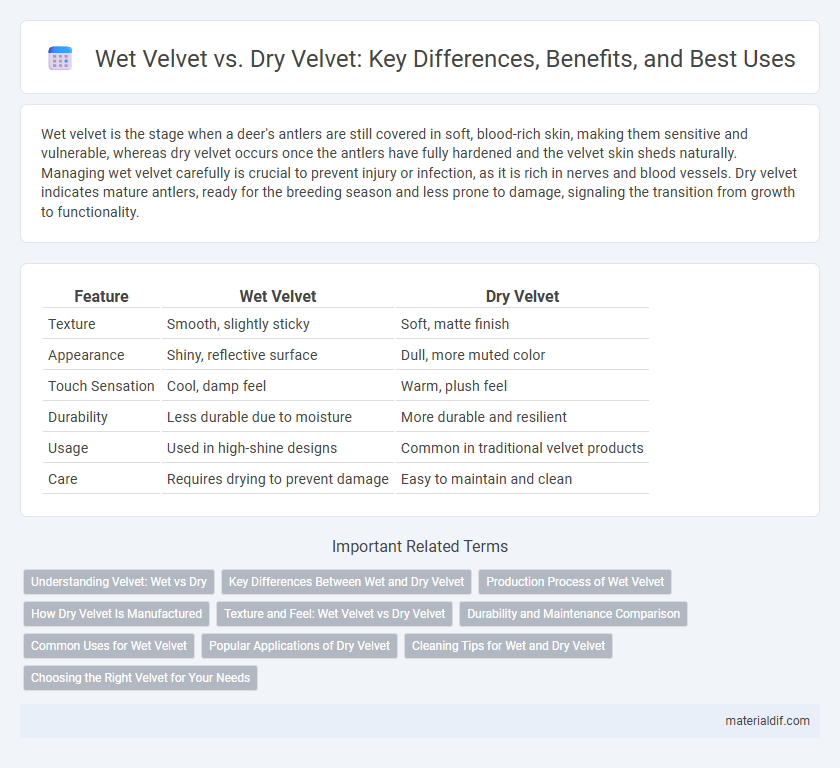Wet velvet is the stage when a deer's antlers are still covered in soft, blood-rich skin, making them sensitive and vulnerable, whereas dry velvet occurs once the antlers have fully hardened and the velvet skin sheds naturally. Managing wet velvet carefully is crucial to prevent injury or infection, as it is rich in nerves and blood vessels. Dry velvet indicates mature antlers, ready for the breeding season and less prone to damage, signaling the transition from growth to functionality.
Table of Comparison
| Feature | Wet Velvet | Dry Velvet |
|---|---|---|
| Texture | Smooth, slightly sticky | Soft, matte finish |
| Appearance | Shiny, reflective surface | Dull, more muted color |
| Touch Sensation | Cool, damp feel | Warm, plush feel |
| Durability | Less durable due to moisture | More durable and resilient |
| Usage | Used in high-shine designs | Common in traditional velvet products |
| Care | Requires drying to prevent damage | Easy to maintain and clean |
Understanding Velvet: Wet vs Dry
Wet velvet exhibits a darker, richer appearance with enhanced depth and softness due to moisture intensifying the pile's texture. Dry velvet, in contrast, reveals a lighter, matte surface where fibers remain upright, emphasizing a crisp and refined look. Understanding the visual and tactile differences between wet and dry velvet is essential for designers and consumers seeking specific aesthetic effects in textiles.
Key Differences Between Wet and Dry Velvet
Wet velvet features a plush, soft texture with a slight sheen caused by moisture, enhancing its depth and richness, whereas dry velvet showcases a matte finish with denser, more compact fibers. The tactile experience of wet velvet is cooler and smoother due to dampness, while dry velvet feels warmer and slightly rougher to the touch. Light interacts differently, with wet velvet reflecting more gloss and dry velvet absorbing light to create a subdued, elegant appearance.
Production Process of Wet Velvet
Wet velvet production involves a unique process where the fabric is exposed to steam or moisture during finishing, enhancing its softness and sheen. This method allows the fibers to swell and align uniformly, creating a plush texture that is more lustrous compared to dry velvet. The steaming process demands precise control of temperature and humidity to maintain the fabric's structural integrity and achieve an even, rich pile.
How Dry Velvet Is Manufactured
Dry velvet is manufactured through a meticulous weaving process where the fabric is woven with a dense base and evenly cut loops to create a plush, textured surface without moisture. This method involves using specialized looms that produce pile yarns standing upright, which are then sheared to achieve a smooth, soft finish synonymous with dry velvet. The absence of water in the finishing stages ensures the fabric maintains its durability, crisp appearance, and enhanced tactile quality compared to wet velvet.
Texture and Feel: Wet Velvet vs Dry Velvet
Wet velvet exhibits a richer, more saturated texture with a smooth, plush feel that enhances its luxurious appearance. Dry velvet, in contrast, has a slightly stiffer and crisper texture, offering a refined matte surface with less sheen. The tactile difference between wet and dry velvet significantly influences its suitability for upholstery, fashion, and decorative applications.
Durability and Maintenance Comparison
Wet velvet tends to have higher durability due to its tighter weave and water-resistant properties, making it less prone to staining and wear over time. Dry velvet, while offering a softer texture, requires more careful maintenance, including gentle cleaning methods and regular brushing to preserve its appearance. Choosing between wet and dry velvet depends largely on the intended use and willingness to engage in routine upkeep to maintain fabric integrity.
Common Uses for Wet Velvet
Wet velvet is primarily used in upholstery and fashion design where a rich, glossy texture enhances visual appeal and tactile experience. Its moisture-retentive fibers make it ideal for creating luxurious drapery, evening wear, and decorative pillows that require a soft sheen and depth of color. Common applications include high-end garments, theater costumes, and plush furniture coverings, where the fabric's vibrant luster can maintain prominence under various lighting conditions.
Popular Applications of Dry Velvet
Dry velvet, characterized by its non-reflective, matte surface, is widely popular in interior design for upholstery, drapery, and accent furnishings, offering a sophisticated, understated elegance. Its texture resists crushing and maintains a crisp, structured appearance, making it ideal for high-traffic areas and formal settings such as luxury hotels, theaters, and upscale residential spaces. Designers favor dry velvet for its durability and ability to enhance natural light diffusion without glare, creating a balanced ambiance in both contemporary and classic decor schemes.
Cleaning Tips for Wet and Dry Velvet
Wet velvet requires gentle blotting with a clean, damp cloth to remove spills without saturating the fabric, while dry velvet benefits from regular vacuuming using a soft brush attachment to lift dust and prevent matting. For both types, avoid harsh chemicals and use specialized velvet upholstery cleaners to maintain texture and color vibrancy. Quick response to stains and consistent care extend the lifespan of velvet furniture and accessories.
Choosing the Right Velvet for Your Needs
Wet velvet offers a richer texture and deeper color saturation, making it ideal for upholstery and drapery where durability and vibrant appearance are essential. Dry velvet has a softer, more matte finish, preferred for clothing and accessories that require lightweight and breathable fabric. Selecting between wet and dry velvet depends on the specific application, desired aesthetic, and fabric performance requirements.
Wet Velvet vs Dry Velvet Infographic

 materialdif.com
materialdif.com